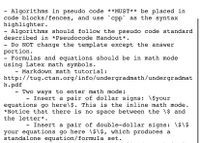
Database System Concepts
7th Edition
ISBN: 9780078022159
Author: Abraham Silberschatz Professor, Henry F. Korth, S. Sudarshan
Publisher: McGraw-Hill Education
expand_more
expand_more
format_list_bulleted
Question
![### Problem 1
Consider the following algorithm to check
connectivity of a graph defined by its adjacency
matrix.
срр
Algorithm Connected (A[0..n-1, 0..n-1]) {
//Input: Adjacency matrix A of an undirected
graph G
7/Output: 1 (true) if G is connected and 0
(false) if it is not
if n
1 return 1; // //one-vertex graph is
==
connected by definition
else {
if not Connected (A[0..n-2, 0..n-2]) return 0;
else {
for j = 0 to n - 2 do {
if A[n-1, j] return 1;
}
return 0;
}
Does this algorithm work correctly for every
undirected graph with `n` vertices? If you answer
YES, indicate the algorithm's efficiency class in
the worst case.
If you answer NO, provide a counter
example.
#### Answer:
Here](https://content.bartleby.com/qna-images/question/b4fac401-f688-4a8e-b637-a2500ce6ac46/0a9770a4-6083-4c06-83f0-096b0750784b/6mn2yyo_thumbnail.jpeg)
Transcribed Image Text:### Problem 1
Consider the following algorithm to check
connectivity of a graph defined by its adjacency
matrix.
срр
Algorithm Connected (A[0..n-1, 0..n-1]) {
//Input: Adjacency matrix A of an undirected
graph G
7/Output: 1 (true) if G is connected and 0
(false) if it is not
if n
1 return 1; // //one-vertex graph is
==
connected by definition
else {
if not Connected (A[0..n-2, 0..n-2]) return 0;
else {
for j = 0 to n - 2 do {
if A[n-1, j] return 1;
}
return 0;
}
Does this algorithm work correctly for every
undirected graph with `n` vertices? If you answer
YES, indicate the algorithm's efficiency class in
the worst case.
If you answer NO, provide a counter
example.
#### Answer:
Here

Transcribed Image Text:Algorithms in pseudo code **MUST** be placed in
code blocks/fences, and use `cpp` as the syntax
highlighter.
Algorithms should follow the pseudo code standard
described in *Pseudocode Handout*.
- Do NOT change the template except the answer
portion.
- Formulas and equations should be in math mode
using Latex math symbols.
Markdown math tutorial:
http://tug.ctan.org/info/undergradmath/undergradmat
h.pdf
Two ways to enter math mode:
Insert a pair of dollar signs: \$your
equations go here\$. This is the inline math mode.
*Notice that there is no space between the \$ and
the letter*.
Insert a pair of double-dollar signs: \$\$
your equations go here \$\$, which produces a
standalone equation/formula set.
Expert Solution
This question has been solved!
Explore an expertly crafted, step-by-step solution for a thorough understanding of key concepts.
This is a popular solution
Trending nowThis is a popular solution!
Step by stepSolved in 2 steps with 1 images

Knowledge Booster
Learn more about
Need a deep-dive on the concept behind this application? Look no further. Learn more about this topic, computer-science and related others by exploring similar questions and additional content below.Similar questions
- Kruskal's minimum spanning tree algorithm is executed on the following graph. Select all edges from edgeList that belong to the minimum spanning tree. edgeList result List AD BC BE CF EF DG EG EH GH D 7 9 G 1 B 5 3 A E H 4 2 6 8 Farrow_forwardAlert dont submit AI generated answer. Write a program that reads a weighted graph and an initial vertex.The program must print on the screen the minimum paths obtained by Dijkstra's algorithm. Input: Receives n, m and s; n is the total number of vertices, m the total number of arcs and s is the initial vertex.Next, m lines, each line with a trio of integers, corresponding to the beginning and end of the arc, followed by the weight of the arc.(Vertices are identified from 0 to n-1.) Output: Prints the shortest paths obtained by Dijkstra's algorithm. Exemple: Input: 5 10 00 1 100 4 51 2 11 4 22 3 43 2 63 0 74 1 34 2 94 3 2 Output: [0, 8, 9, 7, 5][-1, 4, 1, 4, 0]arrow_forwardComputer science question helparrow_forward
arrow_back_ios
arrow_forward_ios
Recommended textbooks for you
 Database System ConceptsComputer ScienceISBN:9780078022159Author:Abraham Silberschatz Professor, Henry F. Korth, S. SudarshanPublisher:McGraw-Hill Education
Database System ConceptsComputer ScienceISBN:9780078022159Author:Abraham Silberschatz Professor, Henry F. Korth, S. SudarshanPublisher:McGraw-Hill Education Starting Out with Python (4th Edition)Computer ScienceISBN:9780134444321Author:Tony GaddisPublisher:PEARSON
Starting Out with Python (4th Edition)Computer ScienceISBN:9780134444321Author:Tony GaddisPublisher:PEARSON Digital Fundamentals (11th Edition)Computer ScienceISBN:9780132737968Author:Thomas L. FloydPublisher:PEARSON
Digital Fundamentals (11th Edition)Computer ScienceISBN:9780132737968Author:Thomas L. FloydPublisher:PEARSON C How to Program (8th Edition)Computer ScienceISBN:9780133976892Author:Paul J. Deitel, Harvey DeitelPublisher:PEARSON
C How to Program (8th Edition)Computer ScienceISBN:9780133976892Author:Paul J. Deitel, Harvey DeitelPublisher:PEARSON Database Systems: Design, Implementation, & Manag...Computer ScienceISBN:9781337627900Author:Carlos Coronel, Steven MorrisPublisher:Cengage Learning
Database Systems: Design, Implementation, & Manag...Computer ScienceISBN:9781337627900Author:Carlos Coronel, Steven MorrisPublisher:Cengage Learning Programmable Logic ControllersComputer ScienceISBN:9780073373843Author:Frank D. PetruzellaPublisher:McGraw-Hill Education
Programmable Logic ControllersComputer ScienceISBN:9780073373843Author:Frank D. PetruzellaPublisher:McGraw-Hill Education

Database System Concepts
Computer Science
ISBN:9780078022159
Author:Abraham Silberschatz Professor, Henry F. Korth, S. Sudarshan
Publisher:McGraw-Hill Education

Starting Out with Python (4th Edition)
Computer Science
ISBN:9780134444321
Author:Tony Gaddis
Publisher:PEARSON

Digital Fundamentals (11th Edition)
Computer Science
ISBN:9780132737968
Author:Thomas L. Floyd
Publisher:PEARSON

C How to Program (8th Edition)
Computer Science
ISBN:9780133976892
Author:Paul J. Deitel, Harvey Deitel
Publisher:PEARSON

Database Systems: Design, Implementation, & Manag...
Computer Science
ISBN:9781337627900
Author:Carlos Coronel, Steven Morris
Publisher:Cengage Learning

Programmable Logic Controllers
Computer Science
ISBN:9780073373843
Author:Frank D. Petruzella
Publisher:McGraw-Hill Education